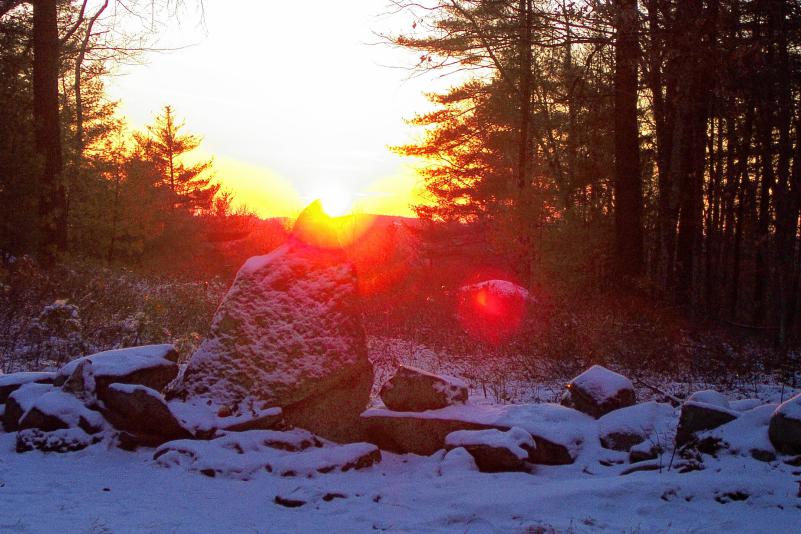This is a sidebar to a feature package I wrote for Sunday’s Monitor about winter solstice celebration at America’s Stonehenge – I thought it would be the piece of most interest to GraniteGeek readers:
Fans of America’s Stonehenge will tell you that the site predates Europeans by hundreds, maybe thousands of years, but unfortunately there’s no evidence to back them up.
It would be cool to think the chambers and “sacrifice stone” and other structures were assembled by Phoenecians or Vikings or Celts, as various folks have suggested, but over the years I’ve talked to a couple of archaeologists who have studied the site and say that everything is consistent with structures, created by Colonial and American farmers all over New England, such as cold cellars and quarry sites.
The biggest difficulty with understanding the site’s history is that in the 1930s, then-owner William Goodwin became convinced it had been home to Irish monks before Columbus arrived and moved some rocks, maybe lots of rocks, to reflect his belief.
Goodwin opened the place to visitors and called it Mystery Hill. The name was changed to America’s Stonehenge in 1982 by later owners, although there’s no connection to Stonehenge in England. (A “henge” is a large circular earthen structure of the sort built by many neolithic peoples; the Salem site doesn’t really have one, either of earth or stone.)
The best argument in favor of the pre-Columbus hypothesis at America’s Stonehenge came from the late Barry Fell, a marine biologist from Harvard University who claimed that markings on some rocks at the site are inscriptions written in ancient scripts.
The most damning arguments against the ancient-creation idea are two: The site has no trash such as broken pottery or burial sites or any of the other detritus always found at ancient sites of human habitation (that’s from Kenneth Feder, then a professor at Central Connecticut State University), and it’s not mentioned in the writings of any early European explorers.
Those folks wrote profusely about everything interesting they found in the New World. It’s hard to believe they’d come across the structure as it now exists and not go crazy.
As for that much-cited sacrifice stone, the carved channels that are claimed to have been used to carry away the blood of victims look exactly the same as channels carved in stones at farms all around new England by people who needed to drain away the lye while making soap, or who were pressing apples to make cider.
This news might be a wet blanket but to a certain extent it doesn’t detract from the site’s pleasures. The stones and stone structures, whatever their history, are very interesting to walk around, sit on and crawl inside of, and the surroundings are beautiful. Just don’t get carried away with your archaeological daydreams.


 Return to the Concord Monitor
Return to the Concord Monitor
Good Day Sir,
I have to admit, that although I grew up in Rhode Island, I am not to familiar with this subject.
I am somewhat of an historian buff and this material always interests me. One question: (probably asked
a few hundred times), The article mention that the stones were moved – are there any existing depictions
of these stones prior to [ this I feel would help with identification of its origins.
Not really, which is part of the problem.
There are many archeological sites attributed to many cultures far too many resemble ancient Akkadian or as they say Phoenician, These can be translated but so many Eurocentric minded refuse to believe fact. Legends has it the ancients frequented the Americas and after the fall of Al-Andalus and newly captured boat building technology seafaring began after 1492 for the invaders from the East. Check the facts it was Henry the navigator that captured Cueto . Sooner or later the real truth will come out suedo-science has been dominant for so long the distortion grows more and more we must stop this or the future will forever promote untruths
What the archeologists say and what the early settlers did do are not on the same playing field. I’ve been there and seen this and it doesn’t match what the early settlers were doing. They were trying to survive not build a giant hedge to follow the seasons. This site parallels many other sites, but it doesn’t fit into the theory that historians keep trying to ram down our throats. I happen to believe there was travel to this continent even before the Vikings made the trek here.
Check out the books, “Celtic America”, “Bronze Age America”, and America B.C. You’ll find them interesting, our country doesn’t want to stray from the 1492 landing as they see it. It’s just unpopular to investigate “new” ideas to find the truth and possibly rock the boat from what they want us to believe.
I would Like to ask some of these so call archaeologists where these primitives and early settlers got the crane and or jigs to transport these large stones at this sight, and a few others in the New England area. Were there giants in on the Earth in those days???